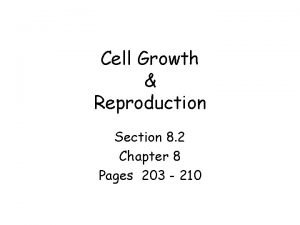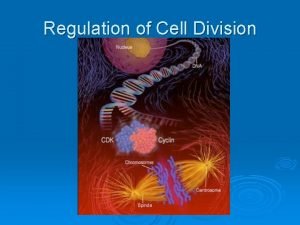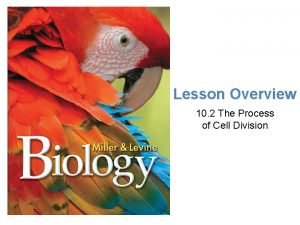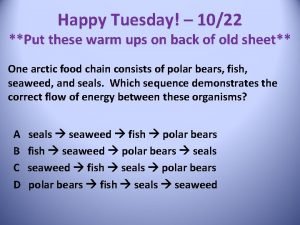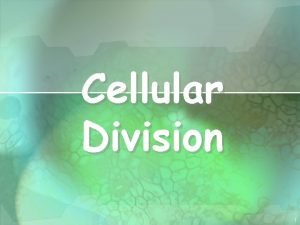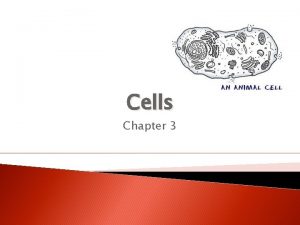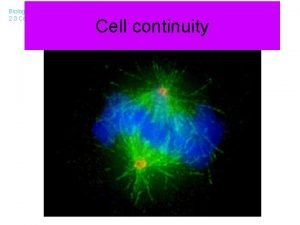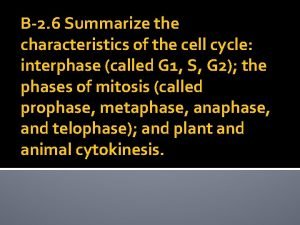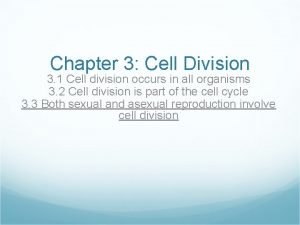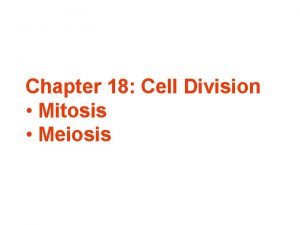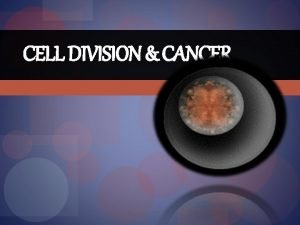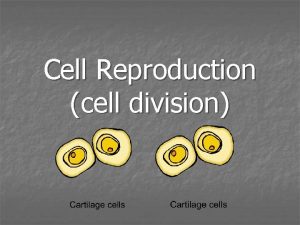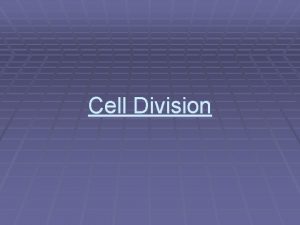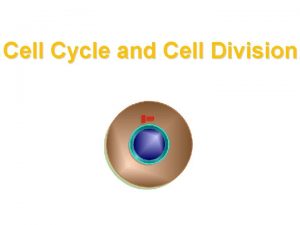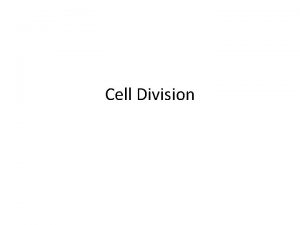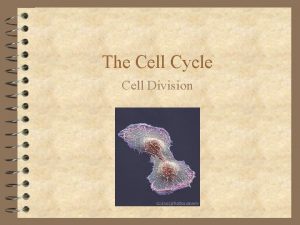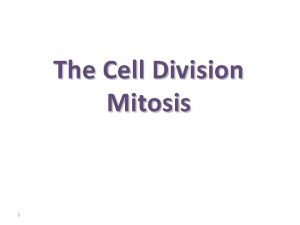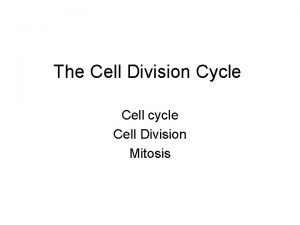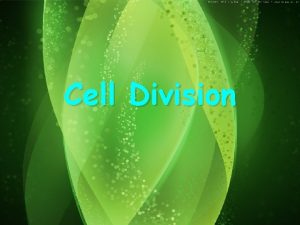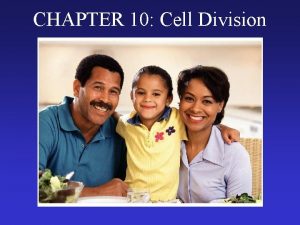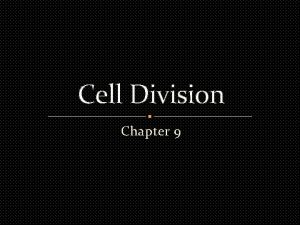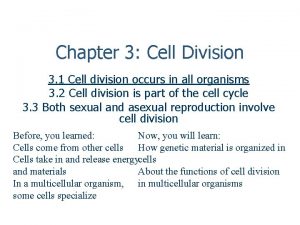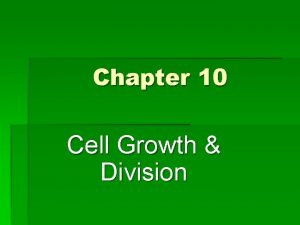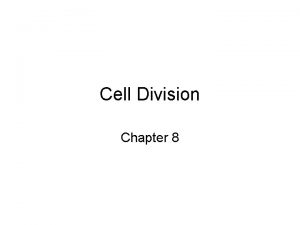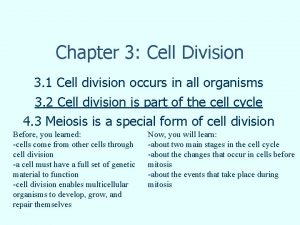Chapter 3 Cell Division 3 1 Cell division



























- Slides: 27

Chapter 3 - Cell Division 3. 1: Cell division occurs in all organisms Mrs. Arsenault 1

Cell division is involved in many functions n n n Cell division occurs in all organisms, but performs different functions Unicellular organisms reproduce through cell division In multi-cellular organisms, cell division is involved in growth, development, repair and reproduction Mrs. Arsenault 2

The genetic material of eukaryotic cells is organized in chromosomes n n n Contains information needed for cell’s growth When a cell divides into 2 new cells, each cell receives a full set of genetic material DNA stores genetic material for cells Mrs. Arsenault 3

DNA and Chromosomes n n n DNA or deoxyribonucleic acid is a chemical that contains information for an organism to grow and function DNA is stored in the nucleus of eukaryotic cells DNA is made of 2 strands of nucleotides joined in a structure that represents a double helix DNA is usually found as loose strands in the nucleus but when the cell gets ready to divide it condenses into chromosomes Each organism has a specific number of chromosomes that form each time the cell divides; humans have 46 Mrs. Arsenault 4

Mrs. Arsenault 5

Cell Division is involved in growth, development, and repair Growth 1. A multi-cellular organism grows because cell division increases the number of cells in it n 2. Organisms develop, cells divide, cells become specialized and continue to divide 3. A large organism does not have larger cells than a smaller organism- it has more cells. Mrs. Arsenault 6

Development and Repair n n n As cells divide and grow into larger organisms, cells become specialized to perform particular functions Examples: Nerve cells, muscle cells , skin cells Cells divide to repair injuries or to replace dead cells with new cells Mrs. Arsenault 7

Mrs. Arsenault 8

3. 2 Cell division is part of the cell cycle Mrs. Arsenault 9

The cell cycle includes interphase and cell division n A cycle is any activity or set of events that regularly repeats n The cell cycle is the normal sequence of development and division of a cell. n n Consists of 2 main phases: one in which the cell carries out its functions called interphase and one in which the cell divides, which can include mitosis and cytokinesis All cells divide but only eukaryotic cells undergo mitosis Mrs. Arsenault 10

Interphase n n n Interphase is the part of the cell cycle during which a cell is NOT dividing. During this phase, the cell grows to about twice its size The cell engages in the normal activities of the cell – such transporting materials in and out of the cell, the process of respiration and photosynthesis…. . Changes that occur during interphase prepare a cell to divide DNA is duplicated so that each new cell gets a complete set of DNA Mrs. Arsenault 11

Cell Division Phase n n Mitosis is the part of the cell cycle during which the nucleus divides Prokaryotic cells do not undergo mitosis because they have no nucleus When the cell divides, each new cell gets a full set of genetic material (DNA) and other cell structures. Cytokinesis is the division of the parent cells cytoplasm. This occurs right after mitosis Mrs. Arsenault 12

Mrs. Arsenault 13

Cell Division produces two genetically identical cells n n Cell division produces daughter cells that are genetically identical to the parent cell The steps of mitosis are divided into 4 phases: 1. Prophase: Chromosomes form; nuclear membrane disappears 2. Metaphase: Chromosomes line up 3. Anaphase: Chromosomes separate 4. Telophase: New nuclear membrane forms and then cytokinesis occurs Mrs. Arsenault 14

Mrs. Arsenault 15

Division of the Cytoplasm n n Cytokinesis is the division of the cytoplasm occurring immediately after mitosis Slight difference in plant vs. animal cells Animal Cells- A fiber ring forms in the center of the dividing cell which contracts until the cell is pinched into 2 daughter cells Plant Cells- The cell wall prevents the membrane from being pulled inward; instead a cell plate grows between the 2 nuclei which eventually becomes part of the cell wall Mrs. Arsenault 16

Mrs. Arsenault 17

3. 3 Both sexual and asexual reproduction involve cell division Mrs. Arsenault 18

How does cell division affect singlecelled organisms? n n In multicellular organisms, cell division functions in growth, repair and development In unicellular organisms, each cell is itself an organism Mrs. Arsenault 19

Asexual reproduction involves one parent n n In multicellular organisms, the daughter cells that result are separate cells but can not live independent lives. Asexual reproduction is the process by which one organism produces one or more new organisms identical to itself that can live independently of it Mrs. Arsenault 20

Cell Division in Unicellular Organisms n Cell division and reproduction are the same thing in all single celled organisms, but the process of cell division in prokaryotes is different than in single celled eukaryotes Mrs. Arsenault 21

Binary Fission Binary fission is the form of asexual reproduction occurring in prokaryotes, when the parent organisms splits in two, producing two completely independent daughter cells Example: Bacteria Mrs. Arsenault 22

Single Celled Eukaryotes n n In single celled eukaryotes, reproduction by cell division occurs by mitosis and cytokinesis, resulting in two separate, independent, and genetically identical offspring Example: algae and paramecium Mrs. Arsenault 23

Budding n n n Budding is a process in which an organisms develops tiny buds on its body, and each bud grows until it forms a complete or nearly complete new organism that is genetically identical to the parent Both unicellular and multicellular organisms can reproduce by budding Examples: unicellular- yeast multicellular- hydra Mrs. Arsenault 24

Regeneration n Regeneration is the process of new tissue growth at the site of a wound or lost limb that occurs only in multicellular organisms One function of regeneration is the regrowth of damaged or missing body parts Examples: Starfish, plants Mrs. Arsenault 25

Asexual Reproduction and Health n n n A population of organisms that reproduce asexually, like bacteria, multiply rapidly through binary fission. For example, 1 cell becomes 2, then 4, then 8, 16 , 32…. . Hand washing and sanitizing can help stop the rapid reproduction of germs! Mrs. Arsenault 26

Comparing Asexual and Sexual Reproduction Asexual Reproduction v Cell division v One parent organism v Rate of reproduction is rapid v Offspring identical to parent n v v Sexual Reproduction Cell division and other processes Two parent organisms Rate of reproduction is slower than that of asexual reproduction Offspring have genetic information from two parents Mrs. Arsenault 27
 Events of the cell cycle
Events of the cell cycle Cell cycle and cell division
Cell cycle and cell division Cell cycle chart
Cell cycle chart Section 8-2 cell division
Section 8-2 cell division The scientist mathias schleiden studied _______ in ______.
The scientist mathias schleiden studied _______ in ______. Short division vs long division
Short division vs long division Example of synthetic division
Example of synthetic division Division traditional method
Division traditional method Example of synthetic division
Example of synthetic division Mitosis pmat diagram
Mitosis pmat diagram Frequency of cell division
Frequency of cell division Mitosis
Mitosis Why is cell division important
Why is cell division important What happens in cytokinesis
What happens in cytokinesis Ipmatc acronym ideas
Ipmatc acronym ideas Telophase
Telophase A sticky semi fluid material found
A sticky semi fluid material found Asexual reproduction cell division
Asexual reproduction cell division Cell division mitosis and meiosis
Cell division mitosis and meiosis Cleavage furrow in cell division
Cleavage furrow in cell division Mitosis division
Mitosis division Cell division leaving cert
Cell division leaving cert Cell cycle diagram labeled
Cell cycle diagram labeled Sexual reproduction vs asexual reproduction venn diagram
Sexual reproduction vs asexual reproduction venn diagram Parts of chromosome
Parts of chromosome Mitosis
Mitosis Unicellular cell division
Unicellular cell division Stage 2 of mitosis
Stage 2 of mitosis



